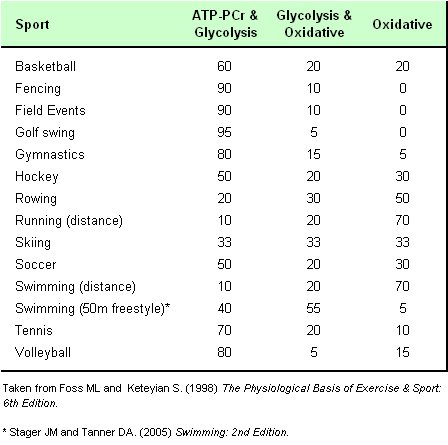![[energy_systems.gif]](https://blogger.googleusercontent.com/img/b/R29vZ2xl/AVvXsEh4-2p4eJ-T9-ZYsh-iITWk9J6wpADZYqNz_9K0lWwj3xkaS6DGaI7E_vrLTTO2-XJ0M-3kbX3CZiO96a9yQLqviysc-X4mGyaKcMJHWb4Jg67LA_zwKFd8_wDs5oEgrvNS_5PdAQ/s1600/energy_systems.gif)

From the chart above we can accurately predict the energy needs of athletes from many different sports, and train them according to those needs. The goal of training within a target energy system is to make the athlete's body more efficient at using the fuel, and more efficient at getting rid of waste products left behind from burning that fuel, namely the H+ (hydrogen) that increase acidity in the muscles, that decrease performance.
For example a 50m freestyle swimmer should train a majority of his or her time within the ATP/PC and Glycolysis energy systems to make themselves as effiencent as possible in using these fuels. That would mean a majority of the training would be work sets of between 0-2 min at high intensity, with low intensity work in between to flush acid out of the muscles, and allow the respitory system (lungs) to exhale as much of the acid as possible. If these energy systems are not trained, when the athlete tries to engage them in a race, their inability to process acid out of the muscles impairs muscular performance, as well as causing breathing issues due to accumulation of acid in the lungs, which is the burning athletes feel in their chest when working at high intensity.
As the ability to flush the acid out of the body improves, rest periods can be decreased in order to continue to improve the body's ability to speed the waste products (acid) out of the body.
I hope this basic overview allows the athlete a glimpse in to how their body's energy is used .
